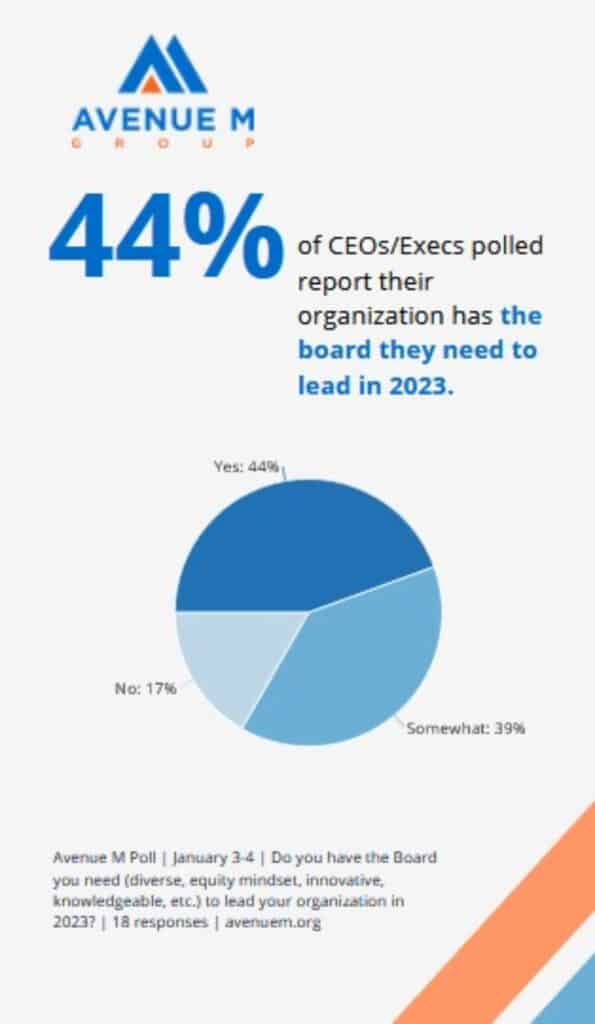44% of association CEOs/Executives say they have the board they need to lead in 2023.
The turbulent events of the past few years have cast an unwavering light on the need for change in all aspects of business and life, and that includes the governing boards of organizations.
Once a very white and male-dominated enclave–78% of board members are white, according to BoardSource’s study Leading With Intent–it is clear that boards must represent the people they serve. The study found that 49% of nonprofit CEOs said they did not have the right board members to “establish trust with the communities they serve.”
And lip service isn’t going to cut it anymore. It has to be real because people are watching and they want to see themselves reflected throughout organizations, including at the top, by people who look like them and understand their needs at a fundamental level.
In a recent poll conducted by Avenue M in early January with 18 association CEOs/Executives, 44% say they have the board they need to lead in 2023, 39% say they somewhat have the board they need, and 17% say they don’t have the board they need.

One executive, who said they have the board they need, shared that they have an extensive screening and nomination process to bring diverse perspectives to the table, while ensuring they have people who “are all committed to our strategic direction and who understand they have a minimal role in operations.”
Another CEO panelist who said their board is ready attributed its success to “members who can wear an industry hat, diversity of individuals and businesses, and strategic thinkers.”
While wanting to have a more diverse, innovative, and knowledgeable board is one thing, actually having one is another. Here are some tips for making it happen.
Click HERE to participate in future polls.
Read our quick summary of the following articles and click the links below.
The Four Principles of Purpose-Driven Board Leadership
To address urgent systemic inequities, boards need to break away from conventional practices, prioritize the organization’s purpose, commit to equity, and understand that people want boards to use their power to help them.
That means focusing on what a board’s essential work needs to be by prioritizing the group’s purpose rather than the organization itself.
Traditionally, boards were focused on an organization’s mission and making sure it did work that advanced its cause. However, this article recommends a reset so that boards shift the focus on the organization’s purpose–i.e., the elemental reason it exists.
Consider “Collective Competency” When Building Boards
When selecting board members, associations have traditionally not given enough thought to collective competency. But it is essential to look at the different talents, skills, and competencies each board member brings to the table that contribute meaningfully to the whole.
To achieve collective competency, it’s a good idea to start by constructing a list of areas where each board member has direct and indirect responsibility. Collecting areas of expertise and matching them to each area of a board’s oversight will help strengthen the board so it can better support relevant demographics, perspectives, and causes.
Practical Steps Toward More Diverse Boards
While many associations are committed to having more diversity on their boards, not everyone has achieved it. “Most boards do not reflect the diversity of their constituencies,” says Cie Armstead, former director of diversity and inclusion at the American College of Healthcare Executives.
The first step in effectively achieving a more diverse board is committing to it. Then work toward diversifying the board, step by step, and build a more diverse leadership pipeline.
Getting outside help is a good idea to gain a better perspective. Recognizing it won’t happen overnight helps, too. Here are three guideposts to start the journey:
- Assess where the board currently stands
- Identify the qualities you want in board candidates
- Abandon exclusionary recruitment practices
Want to be the first to be notified about articles like this?
You can learn more about Avenue M’s new texting poll service HERE. Ready to sign up? Click HERE.
Contributor: Lisa Boylan